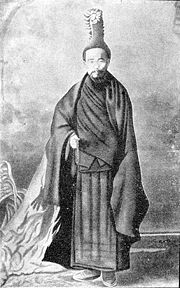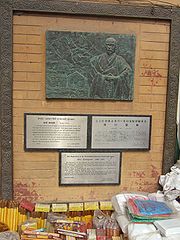- Ekaï Kawaguchi
-
Ekai Kawaguchi
 Kawaguchi as Tibetan lama, Darjeeling.
Kawaguchi as Tibetan lama, Darjeeling.
Ekai Kawaguchi (河口慧海?) (February 26, 1866 – February 24, 1945) was a Japanese Buddhist monk, famed for his four journeys to Nepal (in 1899, 1903, 1905 and 1913), and two to Tibet (July 4, 1900-June 15, 1902, 1913-1915), being the first recorded Japanese citizen to travel in either country.[1][2]
Until March, 1891, he had been the Rector of the Zen Gohyaku rakan Monastery (五百羅漢寺) in Tokyo (which contains 500 rakans - Buddhist images modeled after Buddha's disciples). He then spent about 3 years as a hermit in Kyoto studying Chinese Buddhist texts. He decided to study Tibetan and to travel to Tibet.
He left Japan for Tibet in June, 1897, and returned in May, 1903. According to Sarat Chandra Das he studied Tibetan and English "for several years" dressed as a Japanese priest at the Darjeeling High School before heading to Tibet. He reached Lhasa in the spring of 1901.[3]
Then he left Japan again in October, 1904 for India and Nepal to study Sanskrit and search for more manuscripts.[4]
Reverend Kawaguchi took almost four years to reach Lhasa after stopovers at a number of monasteries and a pilgrimage round sacred Mount Kailash in western Tibet. He posed as a Chinese monk and gained a reputation as an excellent doctor which led to him having an audience with the 13th Dalai Lama, Thubten Gyatso (1876 to 1933).[5] He spent some time living in Sera Monastery.[6]
While Kawaguchi was in Lhasa, 34 year old Narita Yasuteru, who was a spy for the Japanese Intelligence, visited the city for about a fortnight. Little else is known about this man or what information he took back to Japan.[7][8]
Kawaguchi seems to have been quite shocked by the lack of hygiene amongst Tibetans, the filth of Tibetan cities, and by many Tibetan customs, including sexual "immorality", lax practices by many of the monks, corruption and superstitious beliefs. On the other hand, he had great admiration for many Tibetans ranging from great religious and political leaders to common people and made many friends while he was in Tibet.
- "At the turn of the [20th] century, reaching Lhasa Tibet, like reaching the moon in our own day, was such a supreme goal and success so rare an accomplishment that in Japan, as elsewhere, competition and controversy naturally arose regarding the Tibetan journeys of various men. Of the half-dozen Japanese who struck out for Lhasa by 1900, only two met with early success. Ekai Kawaguchi arrived in the spring of 1901, and Narita Yasuteru arrived a few months later. Hiroshi (Kan) Naomi died an unsuccessful attempt [at the hand of tribal people on the borderlands between Yunnan and Tibet], and Enga Teremoto did not achieve the goal until later in 1904.
- Few places in the world have fired the imagination of adventurers like Tibet, and Japanese especially have had more incentive than most other people to reach Lhasa. There was, for example, their interest in promoting pan-Buddhism, pan-Asianism, and a Buddhist renaissance. Then, there was Japan's desire to counter Western imperialism and block Russian expansion. Less than a dozen Japanese reached Tibet during the first half of this [20th] century, and there has been a great deal of debate and competition among Japanese Tibetologists, their disciples and friends as to the accomplishments and comparative value of the Tibetan activities and studies of these pioneers."[9]
While Kawaguchi was often accused of being a spy, and possibly passing on information (some of it perhaps false) to his friend Sarat Chandra Das, who was working for the British, there is no information to back this claim.[10]
He was a friend of Mrs. Annie Besant, President of the Theosophical Society, who encouraged him to publish the English text of his book, Three Years in Tibet.[11]
Kawaguchi spent most of his time in Tibet in disguise and had to flee the country hurriedly. Several of the people who had sheltered him were horribly tortured and mutilated.[12] In 1903 he approached the Nepalese Prime Minister Chandra Shumsher Rana for help and, on his recommendation, the Tibetan Government released Kawaguchi's loyal Tibetan friends from jail.[1] Partly as a result of hearing about the discovery of an Ashoka Pillar in 1896 identifying Lumbini as the birthplace of Gautama Buddha, he visited Lumbini with other Japanese pilgrims in 1912
The Government of Nepal issued a postage stamp in 2003 commemorating Kawaguchi's visits to that country. He is also said to have planted two saplings of Himalayan Cicada trees (also called: Riang Riang; Ploiarium alterifolium), which he had brought back with him, near the gate of the Obaku-san Manpukuji Zen Buddhist temple on the outskirts of Kyoto, where he had studied as a young man[13].
Footnotes
- ↑ a et b "The First Recorded Japanese Visitor: Ekai Kawaguchi" - pdf file from the Japanese Embassy in Nepal. [1]
- ↑ Hyer, Paul (1979). Narita Yasuteru: First Japanese to Enter Tibet". Tibet Journal Vol. IV, No. 2, Autumn 1979, p. 12.
- ↑ Hyer, Paul (1979). Narita Yasuteru: First Japanese to Enter Tibet". Tibet Journal Vol. IV, No. 2, Autumn 1979, pp. 12, 16.
- ↑ Kawaguchi, Ekai (1909): Three Years in Tibet, pages v to vi. Reprint: Book Faith India (1995), Delhi. ISBN 81-7303-036-7
- ↑ Kawaguchi, Ekai (1909): Three Years in Tibet, pp. 309-322. Reprint: Book Faith India (1995), Delhi. ISBN 81-7303-036-7
- ↑ Kawaguchi, Ekai (1909): Three Years in Tibet, pp. 323-328. Reprint: Book Faith India (1995), Delhi. ISBN 81-7303-036-7
- ↑ Paul Hyer, "Narita Yasuteru: First Japanese to Enter Tibet." Tibet Journal VOL.IV, NO.3, AUTUMN 1979, pp. 12-19.
- ↑ See also In this connection, the Center for Asian Historical Records stores the following materials
- ↑ Hyer, Paul (1979): Narita Yasuteru: First Japanese to Enter Tibet> The Tibet journal, Vol. IV, No. 3, Autumn 1979, p. 12.
- ↑ Hopkirk, Peter (1997): Trespassers on the Roof of the World: The Secret Exploration of Tibet, pp. 150-151; 157. Kodansha Globe (Pbk). ISBN 978-1568360508.
- ↑ Kawaguchi, Ekai (1909): Three Years in Tibet, page vii. Reprint: Book Faith India (1995), Delhi. ISBN 81-7303-036-7
- ↑ Hopkirk, Peter (1997): Trespassers on the Roof of the World: The Secret Exploration of Tibet, pp. 149, 154. Kodansha Globe (Pbk). ISBN 978-1568360508.
- ↑ These are now grown into tall trees. From the Japanese embassy in Nepal [2]
References
- Berry, Scott: A Stranger in Tibet: The Adventures of a Wandering Zen Monk. Kodansha International, Tokyo, 1989.
- Hopkirk, Peter (1997): Trespassers on the Roof of the World: The Secret Exploration of Tibet. Kodansha Globe (Pbk). ISBN 978-1568360508.
- Kawaguchi, Ekai (1909): Three Years in Tibet. Reprint: Book Faith India (1995), Delhi. ISBN 81-7303-036-7./ Orchid Press, Thailand. (2003) ISBN 974-524-014-1. Originally published by The Theosophical Office, Adyar, Madras, 1909.
- Subedi, Abhi: Ekai Kawaguchi:The Trespassing Insider. Mandala Book Point. Kathmandu, 1999.
Liens externes
- Brief description and photo of the Obakusan Manpuku-ji Temple
- Photos of Obakusan Manpuku-ji Temple
- more photos of Obakusan Manpuku-ji Temple
- Portail du Japon
- Portail du bouddhisme
- Portail du Tibet
Catégories : Naissance en 1866 | Décès en 1945 | Moine bouddhique japonais | Bouddhisme tibétain | Histoire du Tibet | Personnalité japonaise
Wikimedia Foundation. 2010.

